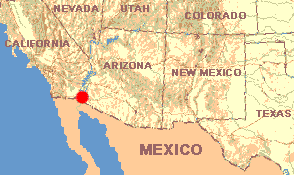 March 14, 1988
March 14, 1988CALIFORNIA: Imperial County Imperial Sand Dunes National Recreation Area just off I-8, fifteen miles west of Yuma.
 March 14, 1988
March 14, 1988Happily, the off-road folks are late sleepers. At dawn the dunes are relatively quiet, with only four sounds:
No birds, no coyotes, no flies...
In low-slanting sunlight one side of every crescent-shaped dune glows intensely while the other side lies inside a cold, black shadow. Looking across several interconnecting dunes, shadows and sunlight combine to form bold arabesques. I wonder: Did such interplays of shadow and sunlight inspire the writing and architectural styles of the desert-living Arabs? As the sun continues to rise, the theater of light and shadow changes so quickly that I can't keep up with it. An hour passes like ten minutes.
In the wind-protected troughs between dunes, the sand's surface is an open book. Trails of lizards, beetles, rodents... but I don't know which lizards, beetles and rodents, or what they were doing here. This open book is in a language to be interpreted only by someone staying longer than I.
The widely spaced plants growing in these troughs are highly specialized to be surviving here, but for the most part I can identify them. The Birdcage Evening-primrose, Oenothera deltoides, has spectacular, three-inch wide, white blossoms shaking in the wind and they show up from a quarter a mile away. The name comes from the fact that at first its stems lie flat on the sand, radiating outward from the taproot, but eventually bend upward, creating a structure that's at least a little like a roofless birdcage.
The Desert Sand-verbena, Abronia villosa, with inch-wide umbels of small, trumpet-shaped, rose-colored blossoms, has its vegetative parts thickly covered with sticky, gland-tipped hairs to which sand-grains adhere in abundance. The plant looks as if it's been dipped in oil, then rolled across the sand. I'm guessing that these stuck-on sand grains serve a purpose. Certainly they cut down on the amount of sunlight reaching the plant's leaves and stems. Maybe that helps the species to survive here. Though this plant with purple-smelling blossoms is very similar to several verbena species, it's not a verbena itself -- not even in the Verbena Family. It belongs to the Four o'Clock Family, the Nyctaginaceae.
Not far away another yellow-flowered member of the Evening-Primrose Family bears flowers with stigmas and styles poking beyond the corollas and stamens, looking like long, round-tipped noses sticking from the blossoms. It's the MUSTARD EVENING-PRIMROSE, Camissonia californica.
In the more level sand away from the dunes our friend the Creosote-bush reappears. However, here the bushes look completely different from the ones we've been seeing all along. These are larger, more widely spaced (averaging about thirty feet apart) and, most conspicuously, they're absolutely loaded with yellow flowers and fuzzy, silvery fruits. Each blossom, about 7/8 of an inch in diameter, bears five petals and ten stamens. Each stamen filament (the part holding up the pollen-producing anther) bears a conspicuous, flat shield between it and the ovary's fuzz -- to prevent self-pollination?
Returning to Henry, right at the trashy base of I-8's levee, I come upon the day's most spectacular, most unexpected botanical discovery. With white, trumpet-shaped blossoms over two inches long, flowering stems seventeen inches high, and grass-like, eight-inch long leaves with curiously crinkled margins, here is the Desert Lily, Hesperocallis undulata, a member of the Lily Family. Usually I think of such exquisite lilies as growing almost exclusively in moist valleys well protected from extremes of temperature and humidity. Finding this luscious species in such a hostile environment just makes my day.